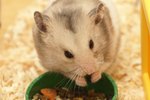They might be small and cute, but Netherland dwarf rabbits need as much care as the largest breeds. Provided you have the space and time, they can make good family pets, although a child certainly should not have sole responsibility. Rabbits need about the same amount of personal space and time spent with you as dogs do.
Basics
As with any other rabbit breed, Netherland dwarfs are happiest in pairs. It doesn't matter what gender they are, because you should get all rabbits spayed or neutered anyway, for health and behavioral reasons as well as to prevent the proliferation of unwanted bunnies. The diet should consist predominately of hay, supplemented with green leafy vegetables and small amounts of commercial pellets. Fresh fruits and sweet vegetables, such as carrots, are fine as treats as long as you don’t feed them too often.
Housing
Because this is a small breed, you can opt for a cage from the smaller end of the rabbit enclosure spectrum available in pet stores; you certainly don’t need to get something purpose-built. It must contain a sheltered area for sleeping, which could be a cardboard box. Bear in mind that the cage is for your Netherland dwarfs to sleep in and for the early stages of toilet training – it is certainly not for 24-hour living. You wouldn’t keep a dog crated all the time, and the same should apply to rabbits. Litter-train your rabbit early and rabbit-proof at least one room of your home, which mainly means protecting electrical cables and the like from a rabbit's mouth.
Substrate and Cleaning
Use hay, which also doubles as food, or a paper-based bedding as the substrate. Provide at least one per rabbit, including one in the cage if you lock your pets up at night, need cleaning once or twice a day. Use a litter specially for rabbits or newspaper -- cat litter is dangerous to rabbits. The cage itself should need cleaning only once a week as soon as the rabbits are using their litter trays exclusively.
Grooming
Netherland dwarfs have short coats and normally just need brushing once or twice a week to help prevent furballs. When they're molting, usually in the spring and fall, increase the frequency of grooming sessions to once a day and use a comb as well as a brush. Grooming tools for short-haired cats are perfect for Netherland dwarfs and other breeds. Clip nails using a pet nail trimmer as required. Rabbits have pretty large feet in relation to their size, so nail trimmers designed for dogs, not cats, tend to be easier to use. If you haven’t clipped a rabbit’s nails before, ask your vet to show you the procedure.
Medical Issues
Because of their unusually small heads, this breed is particularly prone to dental problems, especially overgrown teeth that can cause them to starve. Ask the vet to examine your rabbit’s teeth during an initial checkup. Some Netherland dwarfs need regular tooth-trimming, which your vet can do. Factor in the costs of veterinary care when deciding whether you can afford to keep a rabbit. Never use a cage with a wire bottom and a pan to collect droppings below: Aside from being extremely uncomfortable for the rabbit, this arrangement causes painful foot problems over time. It is also completely unnecessary, since rabbits are among the easiest pets to toilet-train.
References
Writer Bio
Judith Willson has been writing since 2009, specializing in environmental and scientific topics. She has written content for school websites and worked for a Glasgow newspaper. Willson has a Master of Arts in English from the University of Aberdeen, Scotland.





